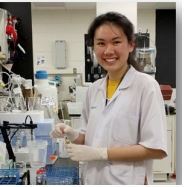Contribution of Soluble Microbial Products on Dissolved Organic Nitrogen and its Biodegradability in Wastewater Effluent

Boonsiri Dandumrongsin is a Master of Science (M.S.) student in Environmental and Conservation Science program at North Dakota State University. She graduated with a Bachelor of Science (B.S.) degree in Environmental Science from Chulalongkorn University, Thailand, in 2013. When she was an undergraduate student, she was studied on heavy metal removal from wastewaters using adsorption methods. Her current study focuses on the contribution of microbial product on nitrogen removal in wastewater effluent.
Email: boonsiri.dandumrongs@ndsu.edu
Phone: 701-541-3179
Fellow: Boonsiri Dandumrongsin
Advisor: Halis Simsek
Degree Progress: M.S. in Environmental and Conservation Sciences Program, expected graduation in fall 2015.
Contribution of soluble microbial products on dissolved organic nitrogen and its biodegradability in wastewater effluent
According to intensive growing in water demand in either agricultural or urban areas, lowering wastewater pollution level is very important and challenging in order to achieve water security toward a sustainable way. Overloading of nitrogen species in natural water ecosystem causes eutrophication and rapid depletion of oxygen. Nitrogen compound also often become a limiting nutrient for aquatic plant in water environment. Dissolved organic nitrogen (DON) in treated effluent mainly consisted of non-biodegraded transformed nitrogen from cell degradation and activity in biological wastewater treatment process. Moreover, resulting of residual organic nitrogen in wastewater effluent reacts with disinfectant and can generate carcinogen substances which are harmful to living organism in aquatic system. In order to reduce DON and biodegradable DON (BDON) level in wastewater treated effluent, the source and sink of DON and BDON in treatment system need to be identified.
During the nitrogen removal in biological treatment process, microorganisms release extracellular polymeric substance (EPS) and soluble microbial products (SMPs). SMPs from activated sludge have been believed to be one of the main surrogates of effluent organic matters (EfOMs). Although a number of previous studies found a clear correlation between effluent dissolved organic carbon (DOC) and SMPs, the contribution of SMP in effluent DON and BDON has not been clear in either suspended- and attached- growth system. This work aims to find contribution of SMPs on effluent DON and BDON in attached growth system.
Project Objectives:
The main scope of this study is to investigate the contribution of SMP and EPS on DON and BDON values in treated effluent of attached growth wastewater treatment system operated under various conditions. The specific objectives of the study are as follows:
- To examine the contribution of DON, EPS and SMP in synthetic wastewater.
- To investigate wastewater characteristics on composition of DON and SMP in the effluent.
- To explore organic loading rate (OLR) effect on composition of DON and SMP in the effluent.
Significance:
This research will provides important information and give better understanding on relationship among DON, BDON, EPS and SMPs for further understand the behavior of the microorganisms in trickling filter units. Additionally, investigation of EPS and SMP effect on DON removal will provide crucial information to understand biofilm created by bacteria on trickling filter media and also use the information to improve the quality of receiving waters. The relationship of DON and EPS will be investigated for the first time.

Halis Simsek
AES Ag & Biosystems Eng
Office: ABEN 2016
Phone: 701-231-6107
Email: halis.simsek@ndsu.edu


